
Wine Culture and Information since 2002 - Volume 22
 Wine Culture and Information since 2002 - Volume 22 |
|
Tasting Wine at HomeOrganoleptic wine tasting can also be done at home with reliable and useful results. Let's see how organizing a wine tasting session at home |
|
Becoming a good wine taster means, first of all, practicing a lot as well as keeping memory and senses well trained. This result can be obtained, obviously, by tasting as many wines as possible. Contrary to common belief, tasters do not assess exceptional or high quality wines only: in order to realize the magnificence of a wine it is also necessary to know - and recognize - its exact opposite, that is lesser quality wines. Every taster knows the educational and professional value offered by a faulty wine: it is a chance to learn to recognize them and sometimes faults in wine are so subtle which require a well trained nose in order to be detected. No matter this can be considered obvious and useless, it is good to remember a great wine is, first of all, a wine having no flaws. The capacity of recognizing faults and therefore the capacity of recognizing their absence, would suggest a concept expressed more than 2,500 years ago by Lao Zi in its famous Dao De Jing: «In the world everyone knows the beauty as beauty and therefore they realize ugliness; everyone knows the good as good and therefore they realize the evil». Such a consideration, even though it can be considered obvious, reminds about the importance of difference and comparison. Likewise great wines can be realized because we recognize bad wines. Whoever is interested in improving one's own tasting skills should try to take advantage from any circumstance in which it is possible to assess a wine, including the situations that could appear as inappropriate at first. Visits to wineries, meals had at restaurants, dinners at friends' houses and wine-food events are just few examples that can provide good opportunities to learn something new. These situations do not provide, of course, the best conditions required for a proper wine tasting, however they however teach something. Keeping your senses continuously trained also means always having new wines available for tasting and, unfortunately, this also means investing some money - even lots of money - and this is not always possible. The best thing would be tasting a wine in ideal conditions of concentration and in a proper environment, as well as having proper tools at hand. Even though it is not possible to anyone to have a specific tasting room, it is however possible to organize useful and reliable wine tasting at home.
In case the economic factor represents a problem for the purchasing of wines, it is a good idea to start a tasting group made of friends who wish to improve their knowledge about sensorial wine tasting. In this way it is possible to share costs for the purchasing of wines and therefore it will be possible to have a higher number of wines available in order to start interesting comparisons and discussions. Starting a wine tasting group is however useful, not only because of costs sharing for the purchasing of wine bottles. The possibility of comparing one's own opinions and sensations about a wine with the other members is useful in order to understand our tasting skills and limits, in other words, a tasting group let every member to improve his or her skills. No matter of the goal of the group, wine samples can be tasted autonomously, without interfering on the tasting job of others, or tasted all together by sharing impressions and opinions during the wine tasting. In the first case it will be possible to compare one's opinions about a wine with the other members at the end of its tasting, or after all the wines scheduled for the session have been tasted. In the second case the tasting is done in an “open” way where every member of the group expresses his or her opinion as the wine is being tasted therefore starting a discussion about that wine. In both cases the results are useful for the education and improvement of one's own tasting skills, however it is good to remember that in the second case, the open tasting method, the risk of being conditioned by opinions of others is pretty high and one can end up perceiving aromas he or she does not perceive at all. The way a tasting is done in a group also depends by their goals. Individual tasting certainly is more formal and however allow the comparison with all the other components to be done at the end of tasting. Open tasting certainly is more fun and, despite the fact it however offers an occasion for learning and improving, also allows to spend some good time in company of friends while remembering the goal of the meeting is to taste wine and not to drink wine.
|
||||||||
|
Even though you decide to organize an informal tasting with your friends, this does not mean you have to neglect caring about all the aspects necessary for a profitable tasting. The first aspect to take care of is deciding the “subject” of the tasting in order to ensure good and useful issues for comparison and discussion. This means wines to be tasted should have one or more characteristics in common, such as “Chardonnay from Bourgogne”, “Chianti Classico 2001”, “Franciacorta and Champagne”, “Rose wines from Salento” and so on. The subject of the tasting can also include vertical tastings (a specific wine of the same producer but of different vintages) or horizontal tasting (the same wine, for example a Barolo, of different producers and belonging to the same vintage). It would make no sense to compare wines belonging, for example, to different types (for examples white, red and sweet wines) having no characteristics in common: they would simply not offer any reason for comparison or discussion saved the fact of being different one from each other.
In general terms every wine tasting has the goal of getting two results: the qualitative assessment of organoleptic and sensorial characteristics of a wine as well as the qualitative determination related to other wines by means of comparative considerations. The evaluation of organoleptic characteristics is done during the first phase, when the wine is being analytically and exclusively examined for its qualities. At the end of this examination follows the qualitative and quantitative comparison in relation to other wines. This second phase, in which it could be thought every wine tasting must necessary include at least two wines in order to allow comparisons, can also be done in case there is only one wine to be tasted. In this specific case the comparison is done with the taster's memory and with the experience gained during all the previous tastings. Qualitative comparison, for example, focuses on the relation between intensity and strength of specific sensorial stimuli, such as intensity of aromas or flavors, whereas qualitative comparison allows the determination of what sample is to be considered the best by analyzing, for example, elegance of aromas, gustatory balance and the nature of possible faults. These goals can be obtained in a more direct and immediate way in case are being tasted more wines during the same event: for this reason it is appropriate to have a specific subject in order to make possible the comparison of the qualities of samples being examined. It should be observed that comparison also means comparing differences among wines. It could be organized a tasting having the subject “red wines produced with Italian grapes” in which will be evaluated four wines from four different areas, such as Nebbiolo delle Langhe, Sagrantino di Montefalco, Aglianico del Vulture and Cannonau di Sardegna. Four completely different wines, although all being red, in which comparative tasting offers the opportunity to study the qualities of each wine and the aspects which differentiate one from each other. The same concept can also be applied to wines produced with the same grapes but coming from different areas in order to compare the differences determined by the territory factor. The number of wines to be tasted in a single session generally depends on the goal, however in case of home wine tasting it seems to be appropriate having not more than six samples. It should be remembered a profitable sensorial tasting, done with attention and concentration, can be very hard for subjects not accustomed to this kind of activity. It should also be remembered that everyone can be subject to sensorial inurement - in particular olfactory - which can take place after a long and continuous sensorial perception. Even in case the meeting is not formal, it is indispensable the wines are to be blind tasted in order to not influence the evaluation of every taster: even the most insignificant clue can be cause of prejudices. For this reason it is necessary to remove the capsules from the bottle which can be put in a bag in order to conceal both the shape and the label. It could be participants know the wines to be evaluated in advance, however it is good to hide the samples from view in order to diminish as much as possible the recognizability of the bottles and of wines. In group tasting a good system is to have two persons doing this operation. The first person, without being seen by others, will put bottles in bags, uncorked and without capsules. The second person, once again without being seen by others, will shuffle the original order of bags and then will assign an identification number on each of them. In case the tasting is done by just one person, it can be asked someone to put bottles in the bags and to number them. The room chosen for the tasting must be sufficiently enlightened and possibly well aerated as well, there must not be any extraneous smell, such as in case of kitchen after its usage. Participants will not smoke, both for not compromising their sensorial capacities and, in particular, for not spoiling the air in the room. For the same reason, it is also recommended no participant makes use of particularly aggressive perfumes. The tasting will be done in a table in which will be put a table-cloth, preferably white, useful for a correct analysis of wine's aspect. In every seat will be put wine glasses, one for every sample to be tasted. It is better to use tasting glasses - such as ISO tasting glass - and it is however advisable that all tasters have the very same type and model of glass in order to ensure a common condition for the evaluation. Wine glasses will be identified with the same numbers assigned to bags. It will also made sure to provide enough space among seats in order to allow the use of notepads for writing comments about every sample. In the center of the table it is good to have a container to be used for emptying glasses or to allow tasters who do not want to swallow wine to expel the sample being examined. It can be used, for example, an ice bucket, an empty flower vase or a pot. In the table will be also present one or more baskets with bread - with a neutral taste - to be used between one tasting and another in order to cleanse the oral cavity and to prepare it for the next wine.
|
||||||||||||
|
A member of the group will be responsible of the service of wines and will begin pouring the sample number one in the glass number one. Before pouring the wine it will speak aloud the number of the sample being served therefore allowing participants to write down the number in their notepads. After having served the last participant, the bottle is brought back together with all the others. The wine is now being examined by tasters in one of the ways discussed above: in complete autonomy or by starting an open discussion among all participants. In the second case you will soon realize a “simple” glass of wine can start a discussion which is most of the times endless. In this case it is easy the spirit of competition could prevail over the real goal of tasting, and this may happen when in the group there are persons whose goal is to appear better and more expert than others. For this reason when you decide to organize a group wine tasting, it is good to scrupulously choose participants while making sure all the members have the very same motivations and interests. After having tasted the first sample, the person responsible for service will pour the wine number two in the glass number two and the operation will be repeated until the end of the tasting. At this point - and before showing the identity of bottles - it is always useful to start a comparative discussion about each sample while trying to emphasize good and bad qualities of each wine in relation to all the others. It can also be created a ranking for all wines by assigning a score which can be the sum of the scores of each taster. For example, it could be assigned a score from 1 to 10 representing the overall value of the wine according to each aspect of the tasting. Bottles will now be drawn from their bags and therefore revealing their identity while participants will write down the name, vintage and producers in their notepads thus replacing the numbers. In this phase participants will be surprised and this will certainly be a reason for discussions, disappointments and wonders. The participants should remember about the cultural and educational purpose of tasting, as well as about the occasion of having spent some good time in company of friends. Have fun and happy tasting!
|
Wines of the Month |
|
|
|
Score legend Prices are to be considered as indicative. Prices may vary according to the country or the shop where wines are bought |
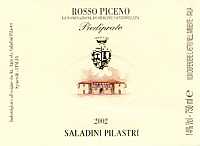
|
|
Rosso Piceno Vigna Piediprato 2002 |
|
| Saladini Pilastri (Italy) | |
| Grapes: Montepulciano (50%), Sangiovese (50%) | |
| Price: € 13,00 | Score: |
| The wine shows an intense ruby red color and nuances of ruby red, little transparency. The nose reveals intense, clean, pleasing and refined aromas that start with hints of black cherry and violet followed by aromas of blueberry, plum, licorice, tobacco, vanilla, cocoa and hints of mace. In the mouth has good correspondence to the nose, a slightly tannic attack and pleasing roundness, however balanced by alcohol, good body, intense flavors, agreeable. The finish is persistent with flavors of plum and black cherry. This wine ages in barrique for 12 months. | |
| Food Match: Roasted meat, Broiled meat and barbecue, Stewed meat, Hard cheese | |
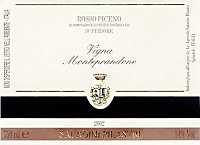
|
|
Rosso Piceno Superiore Vigna Monteprandone 2002 |
|
| Saladini Pilastri (Italy) | |
| Grapes: Montepulciano (70%), Sangiovese (30%) | |
| Price: € 20,00 | Score: |
| This wine shows an intense ruby red color and nuances of ruby red, little transparency. The nose reveals intense, clean, pleasing and refined aromas which start with hints of black cherry and plum followed by aromas of blueberry, carob, violet, tobacco, vanilla, licorice and cinnamon. In the mouth has good correspondence to the nose, a slightly tannic attack and however balanced by alcohol, good body, intense flavors, good tannins. The finish is persistent with flavors of plum, black cherry and blueberry. This wine ages for 18 months in barrique. | |
| Food Match: Braised and stewed meat with mushrooms, Roasted meat, Hard cheese | |
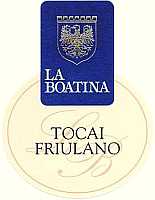
|
|
Collio Tocai Friulano 2003 |
|
| La Boatina (Italy) | |
| Grapes: Tocai Friulano | |
| Price: € 10,50 | Score: |
| This wine shows an intense greenish yellow color and nuances of greenish yellow, very transparent. The nose reveals good personality with intense, clean, pleasing, refined and elegant aromas that start with hints of pear and peach followed by aromas of hawthorn, almond, broom, pineapple, lemon, elder and hints of mineral. In the mouth has good correspondence to the nose, a crisp and pleasing attack, however well balanced by alcohol, good body, intense flavors, agreeable. The finish is persistent with flavors of peach, pineapple, pear and almond. A well made wine. | |
| Food Match: Fried fish, Eggs, Cold cuts, Pasta and risotto with crustaceans and vegetables | |
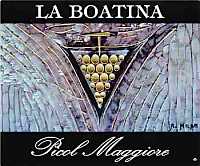
|
|
Collio Rosso Riserva Picol Maggiore 2000 |
|
| La Boatina (Italy) | |
| Grapes: Merlot (70%), Cabernet Sauvignon (20%), Cabernet Franc (5%) | |
| Price: € 15,00 | Score: |
| The wine shows an intense ruby red color and nuances of garnet red, little transparency. The nose denotes intense, clean, pleasing and refined aromas which start with hints of black cherry, plum and violet followed by aromas of carob, licorice, blueberry, vanilla and hints of mint. In the mouth has good correspondence to the nose, a slightly tannic attack and pleasing roundness, however balanced by alcohol, good body, intense flavors, good tannins, agreeable. The finish is persistent with flavors of plum and black cherry. This wine ages for 15 months in cask and followed by an aging in bottle for 15 months. | |
| Food Match: Stewed and braised meat, Roasted and broiled meat, Hard cheese | |
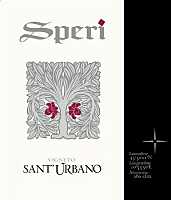
|
|
Valpolicella Classico Superiore Sant'Urbano 2001 |
|
| Speri (Italy) | |
| Grapes: Corvina (70%), Rondinella (25%), Corvinone, Molinara (5%) | |
| Price: € 13,30 | Score: |
| The wine shows an intense ruby red color and nuances of garnet red, little transparency. The nose denotes intense, clean, pleasing and refined aromas which start with hints of black cherry, blackberry and vanilla followed by aromas of blueberry, plum, dried violet, licorice, tobacco and menthol. In the mouth has good correspondence to the nose, a slightly tannic attack and however well balanced by alcohol, good body, intense flavors, good tannins. The finish is persistent with flavors of black cherry, plum and blueberry. A well made wine. This Valpolicella ages for 18 months in cask. | |
| Food Match: Roasted and broiled meat, Braised meat, Hard cheese | |
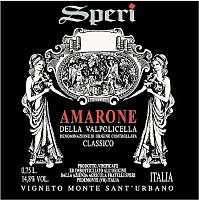
|
|
Amarone della Valpolicella Classico Vigneto Monte Sant'Urbano 2000 |
|
| Speri (Italy) | |
| Grapes: Corvina (70%), Rondinella (25%), Corvinone (5%) | |
| Price: € 39,00 | Score: |
| This Amarone shows a deep ruby red color and nuances of garnet red, little transparency. The nose reveals intense, clean, pleasing, refined and elegant aromas which start with hints of black cherry, blackberry and vanilla followed by aromas of plum jam, dried violet, licorice, tobacco, clove, cocoa, black pepper and menthol. In the mouth has good correspondence to the nose, a slightly tannic attack, pleasing roundness, however well balanced by alcohol, full body, intense flavors, good tannins. The finish is persistent with flavors of blackberry, black cherry and plum jam. A well made wine. This Amarone ages for 36 months in cask. | |
| Food Match: Game, Roasted meat, Stewed and braised meat, Hard cheese | |
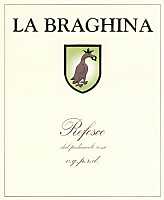
|
|
Lison Pramaggiore Refosco dal Peduncolo Rosso 2003 |
|
| La Braghina (Italy) | |
| Grapes: Refosco dal Peduncolo Rosso | |
| Price: € 9,50 | Score: |
| The wine shows a brilliant ruby red color and nuances of ruby red, moderate transparency. The nose denotes intense, clean and pleasing aromas which start with hints of black cherry and blueberry followed by aromas of raspberry, blackberry, plum and violet. In the mouth has good correspondence to the nose, a slightly tannic attack and pleasing crispness, however balanced by alcohol, good body, intense flavors, good tannins. The finish is pretty persistent with flavors of black cherry and raspberry. | |
| Food Match: Sauteed meat with mushrooms, Stuffed pasta, Broiled meat | |
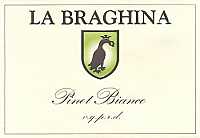
|
|
Lison Pramaggiore Pinot Bianco 2003 |
|
| La Braghina (Italy) | |
| Grapes: Pinot Blanc | |
| Price: € 8,50 | Score: |
| The wine shows a brilliant greenish yellow color and nuances of greenish yellow, very transparent. The nose denotes clean and pleasing aromas which start with hints of pear, broom and lemon followed by aromas of hawthorn, peach and litchi. In the mouth has good correspondence to the nose, a crisp attack and however balanced by alcohol, delicate, intense flavors. The finish is persistent with flavors of pear and peach. | |
| Food Match: Dairy products, Crustaceans appetizers, Pasta and risotto with vegetables | |
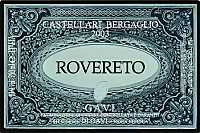
|
|
Gavi di Gavi Rovereto Vignavecchia 2003 |
|
| Castellari Bergaglio (Italy) | |
| Grapes: Cortese | |
| Price: € 9,00 | Score: |
| This wine shows an intense greenish yellow color and nuances of greenish yellow, very transparent. The nose reveals intense, clean, pleasing and refined aromas which start with hints of peach, pineapple, hawthorn and broom. In the mouth has good correspondence to the nose, a crisp attack and however balanced by alcohol, good body, intense flavors. The finish is persistent with flavors of pear, peach and pineapple. This wine ages for at least three months in bottle. | |
| Food Match: Fried fish, Pasta and risotto with vegetables and crustaceans, Dairy products, Sauteed fish | |
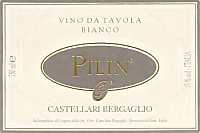
|
|
Pilin 1999 |
|
| Castellari Bergaglio (Italy) | |
| Grapes: Cortese | |
| Price: € 14,00 | Score: |
| The wine shows a pale golden yellow color and nuances of straw yellow, very transparent. The nose reveals good personality with intense, clean, pleasing and refined aromas which start with hints of ripe peach, honey and vanilla followed by aromas of pear, hawthorn, dried apricot, quince jam, broom, almond and ripe banana. In the mouth has good correspondence to the nose, a crisp attack and pleasing roundness, however balanced by alcohol, good body, intense flavors, agreeable. The finish is persistent with flavors of ripe peach, pear and honey. A well made wine. Pilin is produced with slightly dried grapes, ferments in barrique and ages for two years in bottle. | |
| Food Match: Roasted fish, Mushrooms and fish soups, Stuffed pasta, Roasted white meat | |
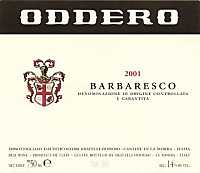
|
|
Barbaresco 2001 |
|
| Oddero (Italy) | |
| Grapes: Nebbiolo | |
| Price: € 23,00 | Score: |
| The wine shows a brilliant garnet red color and nuances of orange red, moderate transparency. The nose denotes intense, clean, pleasing and refined aromas that start with hints of violet and cherry followed by aromas of raspberry, plum, dried rose, tobacco, licorice and vanilla. In the mouth has good correspondence to the nose, a slightly tannic attack and pleasing crispness, however balanced by alcohol, good body, intense flavors. The finish is persistent with flavors of cherry, plum and raspberry. This wine ages in cask. | |
| Food Match: Roasted meat, Braised and stewed meat, Hard cheese | |
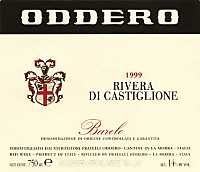
|
|
Barolo Rivera di Castiglione 1999 |
|
| Oddero (Italy) | |
| Grapes: Nebbiolo | |
| Price: € 36,00 | Score: |
| This Barolo shows a brilliant ruby red color and nuances of garnet red, moderate transparency. The nose reveals intense, clean, pleasing and refined aromas which start with hints of cherry and raspberry followed by aromas of plum, dried violet, dried rose, vanilla, licorice, cocoa and cinnamon. In the mouth has good correspondence to the nose, a slightly tannic attack and pleasing crispness, however balanced by alcohol, full body, intense flavors. The finish is persistent with flavors of cherry, raspberry and plum. This Barolo ages in cask. | |
| Food Match: Braised and stewed meat, Roasted meat, Game, Hard cheese | |
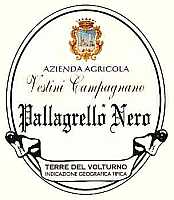
|
|
Pallagrello Nero 2002 |
|
| Vestini Campagnano (Italy) | |
| Grapes: Pallagrello Nero (Aglianico) | |
| Price: € 21,00 | Score: |
| The wine shows an intense ruby red color and nuances of ruby red, little transparency. The nose denotes intense, clean, pleasing and refined aromas which start with hints of violet and plum followed by aromas of black cherry, blackberry, blueberry, licorice, tobacco, pink pepper, cocoa and vanilla. In the mouth has good correspondence to the nose, a slightly tannic attack and pleasing crispness, however well balanced by alcohol, good body, intense flavors. The finish is persistent with flavors of plum and black cherry. A well made wine. Pallagrello Nero ages in barrique for about 15 months followed by at least 3 months of aging in bottle. | |
| Food Match: Roasted meat, Stewed and braised meat, Hard cheese | |

|
|
Casavecchia 2002 |
|
| Vestini Campagnano (Italy) | |
| Grapes: Casavecchia | |
| Price: € 21,00 | Score: |
| This wine shows a deep ruby red color and nuances of ruby red, little transparency. The nose reveals good personality with intense, clean, pleasing and refined aromas which start with hints of black cherry, raspberry and blackberry followed by aromas of blueberry, plum, violet, vanilla, licorice, carob and cinnamon. In the mouth has good correspondence to the nose, a slightly tannic attack and however well balanced by alcohol, good body, intense flavors. The finish is persistent with flavors of black cherry, raspberry and blackberry. A well made wine. Casavecchia ages for about 15 months in barrique followed by at least 3 months of aging in bottle. | |
| Food Match: Roasted meat, Braised and stewed meat, Hard cheese | |

|
|
Sannio Rosato Rosè 2003 |
|
| Torre Gaia (Italy) | |
| Grapes: Sangiovese (50%), Aglianico (50%) | |
| Price: € 4,78 | Score: |
| The wine shows an intense cherry pink color and nuances of cherry pink, transparent. The nose reveals intense, clean and pleasing aromas which start with hints of raspberry and cherry followed by aromas of cyclamen, strawberry, blueberry and plum. In the mouth has good correspondence to the nose, a crisp attack and however balanced by alcohol, good body, intense flavors, agreeable. The finish is persistent with flavors of cherry and raspberry. This wine ages in steel tanks for 6 months. | |
| Food Match: Broiled fish, Fish soups, Pasta with fish and meat, Roasted white meat | |

|
|
Sannio Rosso Aia Vecchia 2000 |
|
| Torre Gaia (Italy) | |
| Grapes: Montepulciano (50%), Aglianico (50%) | |
| Price: € 21,58 | Score: |
| This wine shows an intense ruby red color and nuances of ruby red, moderate transparency. The nose reveals intense, clean and pleasing aromas that start with hints of black cherry, violet and plum followed by aromas of blueberry, vanilla, licorice and hints of eucalyptus. In the mouth has good correspondence to the nose, a slightly tannic attack and however balanced by alcohol, good body, intense flavors. The finish is persistent with flavors of black cherry, plum and blueberry. This wine ages in cask for 18 months followed by at least 6 months of aging in bottle. | |
| Food Match: Stewed meat, Roasted meat, Broiled meat and barbecue | |

|
|
Giardini Arimei |
|
| Muratori (Italy) | |
| Grapes: Biancolella, Forastera, Uva Rilla, San Lunardo, Coglionara | |
| Price: € 21,00 - 500ml | Score: |
| This wine shows a brilliant amber yellow color and nuances of amber yellow, transparent. The nose reveals good personality with intense, clean, pleasing and elegant aromas which start with hints of dried fig, dried apricot and almond followed by aromas of peach jam, quince jam, date, honey, rhubarb, vanilla and hints of enamel. In the mouth has good correspondence to the nose, a sweet attack and however balanced by alcohol, good body, intense flavors, agreeable. The finish is persistent with flavors of rhubarb, peach jam and honey. Giardini Arimei is produced with overripe grapes and ages for 18 months in cask. | |
| Food Match: Hard cheese, Fruit tarts, Confectionery | |
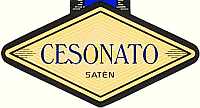
|
|
Franciacorta Satèn Villa Crespia Cesonato |
|
| Muratori (Italy) | |
| Grapes: Chardonnay | |
| Price: € 20,00 | Score: |
| This Franciacorta shows a pale golden yellow color and nuances of straw yellow, very transparent, good effervescence, fine and persistent perlage. The nose reveals intense, clean, pleasing and refined aromas which start with hints of pear, yeast and hawthorn followed by aromas of pineapple, banana, kiwi, bread crust, apple and plum. In the mouth has good correspondence to the nose, a crisp and effervescent attack, however well balanced by alcohol, good body, intense flavors, agreeable. The finish is persistent with flavors of pineapple, plum and apple. The must of this Franciacorta ferments in barrique and ages in bottle on its lees for 24 months. | |
| Food Match: Pasta and risotto with fish and crustaceans, Broiled crustaceans, Sauteed fish | |
|
||||||||
|
DiWineTaste Polls
|
| |||||||
Privacy Policy | |||||||


| Copyright © 2002-2024 Antonello Biancalana, DiWineTaste - All rights reserved |
| All rights reserved under international copyright conventions. No part of this publication and of this WEB site may be
reproduced or utilized in any form or by any means, electronic or mechanical, without permission in writing from DiWineTaste. |